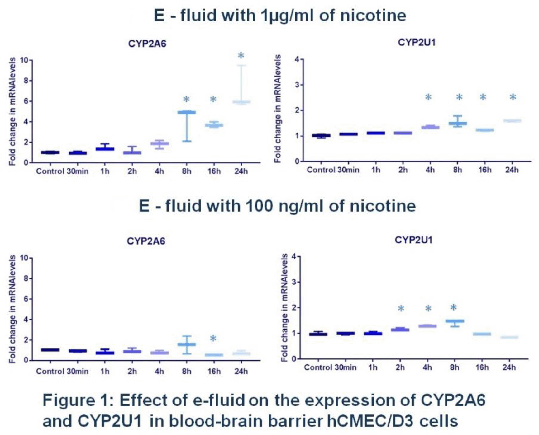Print version
Search Pub Med
| 027P London, UK Pharmacology 2017 |
Effects of nicotine and E-cigarette fluids on cytochromes P450 in hCMEC/D3 blood-brain barrier cell line.
Introduction: Electronic cigarettes (EC) were introduced into the market as a safer alternative to tobacco, however, there is limited information on possible adverse health effects, especially after long term use. Among potential harmful constituents of EC aerosols nicotine is the major addictive chemical and is a precursor for carcinogenic tobacco-specific nitrosamines (TSNAs). Multiple studies have highlighted the ability of nicotine to compromise blood brain barrier (BBB) integrity, altering transport and receptor systems1. This raises concerns of potential susceptibility to neurotoxicity, histopathology and cancer. Therefore, the aim of this study was to examine the effect of nicotine and e-fluid on the expression of drug metabolising cytochrome P450 enzymes (CYPs) in a promising in vitro model of human BBB, the hCMEC/D3 cell line. Given that liver is the primary site for nicotine metabolism, a comparison was then made to the hepatic HepaRG cell line.
Method: The hCMEC/D3 cells were initially used to determine any time course responses to 1μg/ml and 100ng/ml of nicotine or e-fluid (corresponding nicotine concentration). Dose response curves for both hCMEC/D3 and HepaRG cells were generated for nicotine ranging from 0 to 1μg/ml (nicotine only, e-fluids and EC aerosol condensate). High quality RNA was extracted and analysed by qRT-PCR for the expression of genes encoding enzymes involved in nicotine metabolism and bioactivation of procarcinogens (CYP2A6, CYP1A1, CYP2E1, CYP3A4, CYP2A13, CYP1A2) and recently described extrahepatic CYP isoforms (CYP2U1 and CYP2S1), which are highly expressed in BBB2.
Results: qRT-PCR results were normalised using UBC reference gene and expressed as a fold change between non treated and treated cells (n=3, p<0.05). Initial transcriptional analysis revealed a time-dependent increase in mRNA expression levels of CYP2A6, CYP2U1, CYP2E1 and CYP2S1 following exposures with the highest fold change values after 24h (Figure 1). There was no expression of CYP3A4, CYP1A2 and CYP2A13. The data obtained from dose-response treatment will be presented.
Conclusion: Significant induction of mRNA expression for CYP2A6 and CYP2E1 following treatment with nicotine and e-fluid, suggests that BBB may play an active role in nicotine metabolism and possibly contribute to the bioactivation of procarcinogens. Similar results have been observed for CYP2U1 and CYP2S1, however, the role of these isoforms in the metabolism of drugs remains to be demonstrated.

References:
1. Mohammad AK et al. (2016). Toxicology 365: 67-75.
2. Dauchy S et al. (2009). Biochem Parmacol 77: 897-909.

